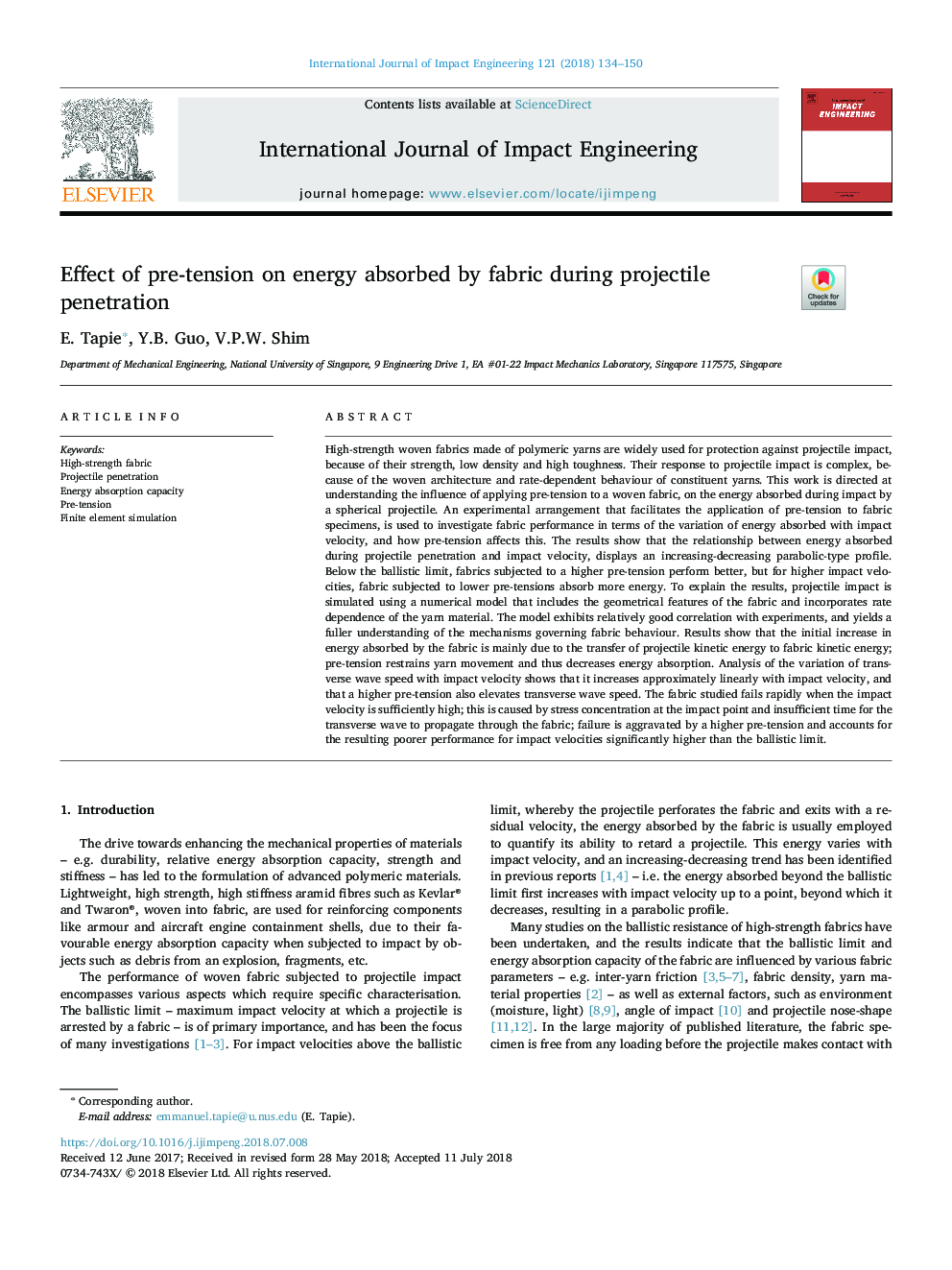| کد مقاله | کد نشریه | سال انتشار | مقاله انگلیسی | نسخه تمام متن |
|---|---|---|---|---|
| 7172888 | 1464030 | 2018 | 17 صفحه PDF | دانلود رایگان |
عنوان انگلیسی مقاله ISI
Effect of pre-tension on energy absorbed by fabric during projectile penetration
ترجمه فارسی عنوان
اثر پیش تنش بر روی انرژی جذب شده توسط پارچه در طول نفوذ پرتابه
دانلود مقاله + سفارش ترجمه
دانلود مقاله ISI انگلیسی
رایگان برای ایرانیان
کلمات کلیدی
پارچه ای با استحکام بالا نفوذ پروجکتی، ظرفیت جذب انرژی، قبل از تنش، شبیه سازی عنصر محدود،
ترجمه چکیده
پارچه های بافته شده بافته شده از نخ های پلیمری به طور گسترده ای برای حفاظت در برابر ضربه پرتابه به علت قدرت، تراکم و چقرمگی بالا مورد استفاده قرار می گیرند. پاسخ آنها به اثرات پرتابه پیچیده است، به دلیل معماری بافته شده و رفتار وابسته به سرعت از نخ های تشکیل دهنده. این کار برای شناخت نفوذ استفاده از پیش تنش به یک پارچه بافته شده، بر روی انرژی جذب شده در اثر یک پرتابه کروی هدایت می شود. یک روش آزمایشی که تسهیل استفاده از پیش تنش به نمونه های پارچه را تسهیل می کند، برای بررسی عملکرد پارچه از لحاظ تغییر انرژی جذب شده با سرعت ضربه، و نحوه پیش کشیدن بر این تاثیر می گذارد. نتایج نشان می دهد که رابطه بین انرژی جذب شده در هنگام نفوذ پرتابه و سرعت ضربه، یک نمایه نوعی پارابولی رو به افزایش را نشان می دهد. در زیر محدودیت بالستیک، پارچه هایی که تحت فشار قبل از انقباض قرار می گیرند، بهتر عمل می کنند، اما برای سرعت های بالاتر، پارچه هایی که قبل از انقباض کمتر قرار دارند، انرژی بیشتری را جذب می کنند. برای توضیح نتایج، تاثیر پرتابه شبیه سازی شده با استفاده از یک مدل عددی که شامل ویژگی های هندسی پارچه است و شامل وابستگی نرخ مواد نخ است. این مدل با آزمایشات همبستگی نسبتا خوب دارد و درک کاملتری از سازوکارهای رفتارهای پارچه ای را به ارمغان می آورد. نتایج نشان می دهد که افزایش اولیه انرژی جذب شده توسط پارچه به طور عمده به دلیل انتقال انرژی جنبشی پرتابه به انرژی سینتیکی پارچه است؛ پیش تنگی حرکت حرکت نخ را محدود می کند و بنابراین جذب انرژی را کاهش می دهد. تجزیه و تحلیل تغییر سرعت موج عرضی با سرعت ضربه نشان می دهد که آن را تقریبا به صورت خطی با سرعت ضربه افزایش می دهد و همچنین پیش تشدید بالاتر باعث افزایش سرعت موج عرضی می شود. پارچه مورد مطالعه به سرعت در حال شکستن است، زمانی که سرعت ضربه به اندازه کافی بالا است؛ این ناشی از تمرکز استرس در نقطه ضربه و زمان کافی برای انتقال موج از طریق پارچه است؛ شکست ناشی از یک پیش تشدید بالاتر و حساب کاربری برای عملکرد ناخوشایندی برای سرعتهای ضربه به میزان قابل توجهی بالاتر از حد بالستیک است.
موضوعات مرتبط
مهندسی و علوم پایه
سایر رشته های مهندسی
مهندسی مکانیک
چکیده انگلیسی
High-strength woven fabrics made of polymeric yarns are widely used for protection against projectile impact, because of their strength, low density and high toughness. Their response to projectile impact is complex, because of the woven architecture and rate-dependent behaviour of constituent yarns. This work is directed at understanding the influence of applying pre-tension to a woven fabric, on the energy absorbed during impact by a spherical projectile. An experimental arrangement that facilitates the application of pre-tension to fabric specimens, is used to investigate fabric performance in terms of the variation of energy absorbed with impact velocity, and how pre-tension affects this. The results show that the relationship between energy absorbed during projectile penetration and impact velocity, displays an increasing-decreasing parabolic-type profile. Below the ballistic limit, fabrics subjected to a higher pre-tension perform better, but for higher impact velocities, fabric subjected to lower pre-tensions absorb more energy. To explain the results, projectile impact is simulated using a numerical model that includes the geometrical features of the fabric and incorporates rate dependence of the yarn material. The model exhibits relatively good correlation with experiments, and yields a fuller understanding of the mechanisms governing fabric behaviour. Results show that the initial increase in energy absorbed by the fabric is mainly due to the transfer of projectile kinetic energy to fabric kinetic energy; pre-tension restrains yarn movement and thus decreases energy absorption. Analysis of the variation of transverse wave speed with impact velocity shows that it increases approximately linearly with impact velocity, and that a higher pre-tension also elevates transverse wave speed. The fabric studied fails rapidly when the impact velocity is sufficiently high; this is caused by stress concentration at the impact point and insufficient time for the transverse wave to propagate through the fabric; failure is aggravated by a higher pre-tension and accounts for the resulting poorer performance for impact velocities significantly higher than the ballistic limit.
ناشر
Database: Elsevier - ScienceDirect (ساینس دایرکت)
Journal: International Journal of Impact Engineering - Volume 121, November 2018, Pages 134-150
Journal: International Journal of Impact Engineering - Volume 121, November 2018, Pages 134-150
نویسندگان
E. Tapie, Y.B. Guo, V.P.W. Shim,
